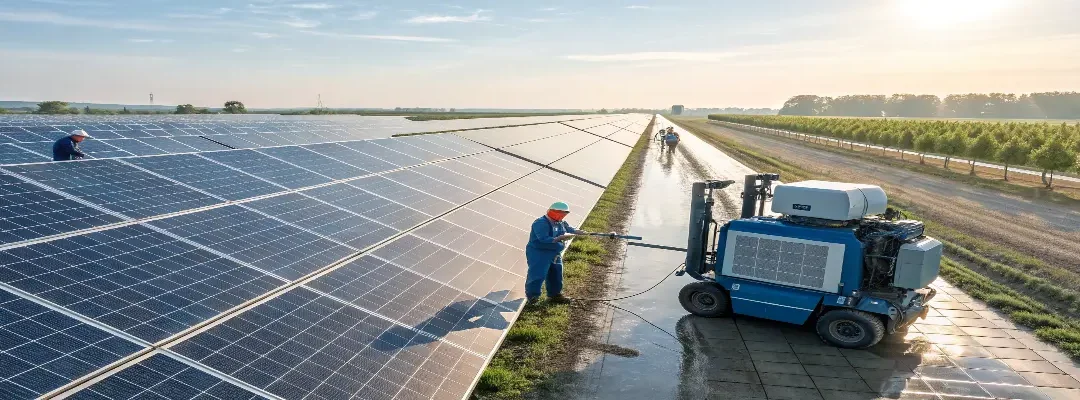Solar farms spread across hundreds of acres generate megawatts of power daily. But dust, sand, and pollution can reduce output by 10–30%, costing operators crores in lost revenue.
The solution? Solar panel cleaning machines — from robotic cleaners to tractor-mounted systems — that keep panels dust-free, reduce operating costs, and maximize ROI for large-scale solar farms.
The Cost of Dirty Panels in Solar Farms
- Dust accumulation reduces efficiency, leading to lower power generation.
- A 100 MW solar farm can lose over ₹15–20 crore annually if panels are not cleaned regularly.
- Manual cleaning requires water tankers, labor, and time, which increases O&M costs.
How Cleaning Machines Save Money
1. Higher Energy Output = More Revenue
- Regular machine cleaning restores 10–15% more power generation.
- Example: For a 50 MW farm, even a 10% gain equals ₹5–7 crore extra revenue annually.
2. Reduced Water Costs
- Manual cleaning of 1 MW needs 7,000–10,000 liters of water.
- Robotic waterless machines save millions of liters every year.
- This reduces not only water costs but also logistics expenses.
3. Lower Labor Dependency
- Manual cleaning = hundreds of workers for large farms.
- Machines (robots or tractors) clean faster with fewer staff.
- Cuts down on recurring labor expenses and improves safety.
4. Longer Panel Life
- Machines use soft brushes/microfibers → no scratches.
- Prevents long-term damage, avoiding costly replacements.
5. Faster ROI on Solar Farms
- With higher generation and reduced O&M costs, payback periods shrink.
- Cleaning machines pay for themselves within 1–3 years.
Case Example: Rajasthan Solar Park (100 MW)
- Manual cleaning: ₹1.2 crore/year (water + labor).
- Robotic waterless cleaning machines: ₹40 lakh/year O&M.
- Annual savings: ₹80 lakh + 12% higher energy revenue (~₹18 crore).
- Payback period for machines: 2 years.
Machines Used in Solar Farms
- Robotic Waterless Cleaners → Autonomous, rail-based, AI-powered.
- Tractor-Mounted Cleaning Systems → Cover thousands of panels in hours.
- Semi-Automatic Brush Machines → Low-cost option for mid-scale farms.
The Bigger Picture: Long-Term Financial Benefits
- Operational Savings: Lower manpower, water, and logistics costs.
- Energy Yield Maximization: Ensures farms meet PPA obligations.
- Sustainability Compliance: Waterless cleaning aligns with green goals.
- Investor Confidence: Consistent returns improve financing opportunities.

